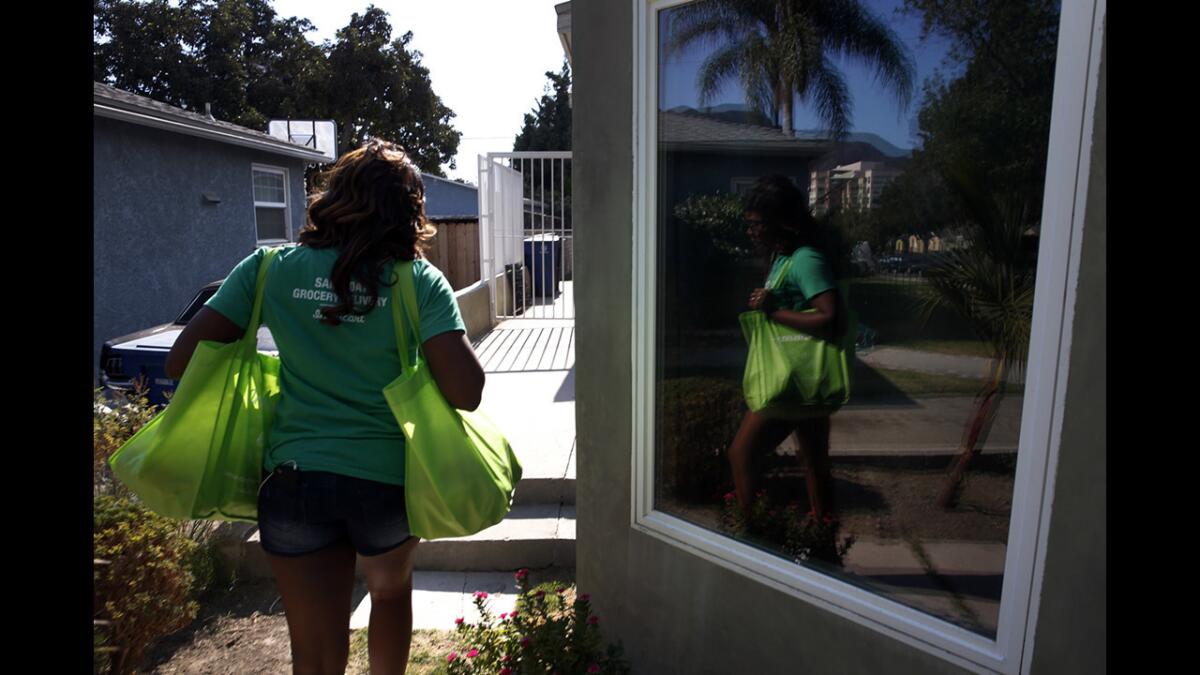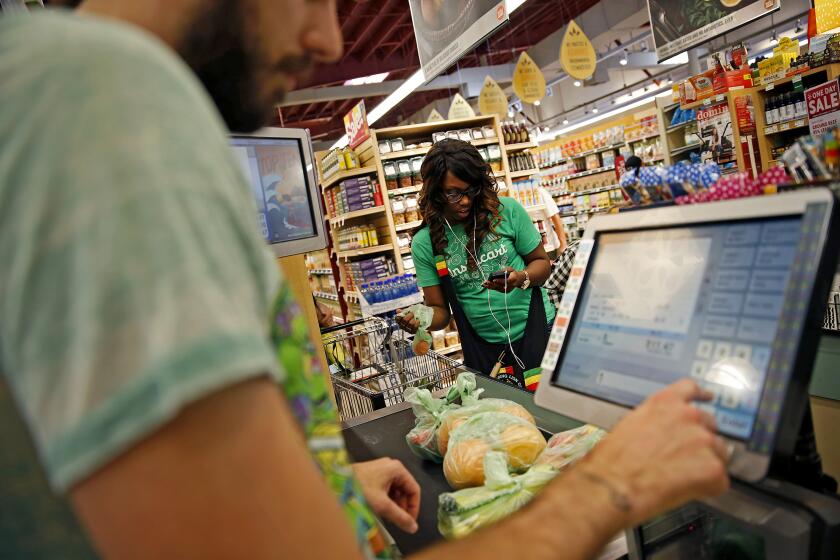A smaller competitor to Instacart is a better deal for shoppers

Kelli Vilchis loves to shop. When she went looking for a flexible side hustle that would suit a young mom, being a personal shopper for Instacart seemed like a natural fit. But as the shopping scene changed, it became tougher to earn a decent living with Instacart. So Vilchis went into business for herself.
She’s now earning between $3,000 and $5,000 a month, operating her own personal shopper business under the moniker ShopGirl OC.
“This is such a low stress, low expense business. It really works for us,” says Vilchis, who often shops with her 16-month-old in tow. “It’s been a bit of a surprise of how well it has been going.”
Instacart is well-known for enlisting freelancers to shop for other people’s groceries. However, making a decent hourly wage with this app became increasingly challenging in a COVID-changed world. That’s partly because the app sets the terms of work, including the delivery fee. And that fee hasn’t been adjusted for today’s market, where personal shoppers can spend hours waiting in line to find still-scarce supplies.
Demand for Instacart’s grocery deliveries has put new strains on the company’s shoppers, who say they have little to show for risking their health.
Shoppers say that the only way to make a decent hourly wage with Instacart these days is to get a good tip. But Instacart’s policies make tips tenuous. How so? Instacart provides shoppers with an estimated payout, which includes the customer’s tip, before they accept an assignment. However, the app allows customers to reverse the promised tip after the delivery.
As demand for personal shoppers soared, customers increasingly promised big tips to get shoppers to accept their orders. However, after the groceries were delivered, many of these tips were canceled. Instacart shoppers consider this bait-and-switch and say the site does little to discourage it.
The alternative? A smartphone app called Dumpling helps set shoppers up in business for themselves. With this app, you say when you’re available and how much you charge to shop and deliver. You even set your own minimum tip. If the customer books your service, they are contractually obligated to pay all the fees, including the tip.
This allows shoppers to price for things like distance to the store and whether they’re likely to wait in line.
“Dumpling isn’t our boss. We are our own boss,” says Vilchis, who pays $39 a month to have the app provide billing and support for her shopping operation. “We essentially own our own business.”
Dumpling differs from Instacart in a variety of other ways too. First, when you buy groceries through Instacart, you pay a mark-up on each item. That mark-up may or may not be apparent to the customer.
There is no grocery mark-up with Dumpling. When you buy groceries through Dumpling, the app estimates the cost. But the real cost will be whatever the shopper pays to complete your order, plus shopper and site fees. You are provided a receipt, showing how much was paid for each item.
Additionally, customers choose their Dumpling shopper based on location and the shopper’s reviews. Assuming you like that person, you can have that same shopper complete your order every time. (With Instacart, you get whoever is available. You can’t request a specific shopper.) This allows you to get to know your Dumpling shopper; and it presumably allows the shopper to understand your preferences well enough to do an increasingly good job.
Vilchis says forming continuing relationships with her customers is particularly handy now. It allows her to pick up scarce items when she can. She then simply offers them to clients as an add-on, if they want them later.
When toilet paper was scarce, for instance, she bought a big Costco pack and then asked some of her regular customers if they wanted to share it, each taking one of the five six-roll packages.
“I did the same with the paper towels and Clorox wipes,” she says. “People were really appreciative that I was doing that because it was so hard to find these things at the store.”
However, whereas shoppers with Instacart only have to pay for their own transportation and insulated bags, Dumpling shoppers have to pay fees to list and sell their services through the platform too. That said, Dumpling’s fees are modest.
There’s a $10 fee to get set up on the site. That gives you access to a Dumpling credit card, a listing on the company’s website and Dumpling’s ZIP Code-fueled shopper search tool. In addition, shoppers pay either a $39 monthly fee or a $5 per-transaction fee each time they book a job.
The two-tier fee structure helps keep costs low for those who are just getting started, says CEO Joel Shapiro. However, as shoppers build up a clientele, as Vilchis has, it’s cheaper to pay a monthly fee.
Dumpling also adds a 5% fee onto customer orders for payment processing.
You also get access to a coach on Dumpling, who can give you help and advice about marketing your business. Shapiro says this became a key service provided by the site because they found that personal shoppers were able to grow their businesses dramatically when experienced shoppers who were already successful on the platform provided advice.
“It’s a big mind shift from having gigs doled out to you to being a business owner,” says Shapiro. “You’re doing your own marketing and promotions and setting your own prices. The coaches help take [personal shoppers] to the next level.”
The one big risk that shopper/business owners face on Dumpling that they don’t face elsewhere is customer fraud. If a customer fails to pay for their groceries, the shopper is on the hook for the cost.
Although Dumpling advances the estimated cost of a shopping trip on the shopper’s card, it’s a temporary credit. When the transaction is complete, the site charges the customer’s card for both the groceries and the fees.
If the customer’s credit card doesn’t have sufficient funds, the shopper bears the risk of not getting paid, according to Dumpling’s terms. Shapiro says that because most shoppers have continuing relationships with their clients, customer fraud is rare. However, it does occasionally happen.
So far, Shapiro says Dumpling has reimbursed shoppers, even though its terms don’t require it. The site is considering adding an insurance policy to protect against that risk in the future.
Kristof is the editor of SideHusl.com, an independent site that reviews hundreds of money-making opportunities in the gig economy.
More to Read
Inside the business of entertainment
The Wide Shot brings you news, analysis and insights on everything from streaming wars to production — and what it all means for the future.
You may occasionally receive promotional content from the Los Angeles Times.











